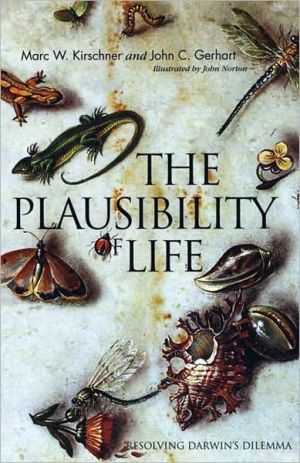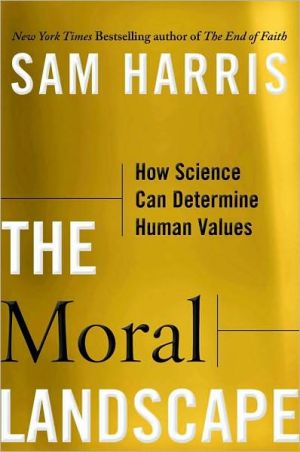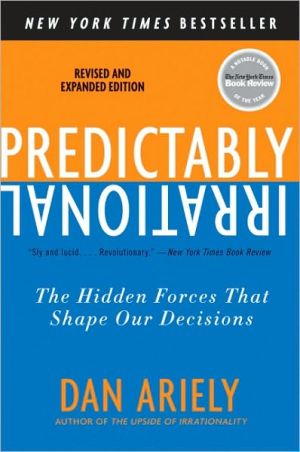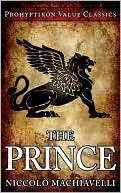The Plausibility of Life: Resolving Darwin's Dilemma
Offering daring new ideas about evolution, two highly respected biologists here tackle the central, unresolved question in the field—how have living organisms on Earth developed with such astounding variety and complexity? Marc Kirschner and John Gerhart draw on cutting-edge biological and medical research to provide an original solution to this longstanding puzzle.\ "In this terrific new book, molecular systems meet evolution. The result is a wealth of stimulating ideas set among clear...
Search in google:
Two eminent biologists tackle and provide exhilarating new answers to what they argue is the central, unresolved question of evolution
The Plausibility of Life\ Resolving Darwin's Dilemma \ \ By Marc W. Kirschner John C. Gerhart \ Yale University Press\ Copyright © 2005 Marc W. Kirschner and John C. Gerhart\ All right reserved.\ ISBN: 978-0-300-11977-0 \ \ \ Chapter One\ The Sources of Variation \ Physical scientists in the nineteenth and early twentieth centuries had astounding success in formulating very general yet predictive theories in thermodynamics, electricity and magnetism, and atomic structure. Biology sought a similar level of generalization and had signal success in the cell theory, the germ theory of disease, metabolism, and heredity. Darwin's theory of evolution was perhaps the most ambitious effort to understand the living world, but unlike the others it was historically based and hard to test experimentally. Even to be comprehensible, it required an accumulation of knowledge from natural history, genetics, and paleontology. Biology differed from physics in that its most obvious characteristics are complexity and diversity; therefore the origin of that complexity and diversity would remain at the center of biological concerns. At the end of the nineteenth century, evolution was an unfinished, still controversial theory. An explanation of the origin of variation was one of the big gaps. The incompleteness of the theory was a problem for all of biology; biologists wouldcontinually return to it to add their perspectives.\ The Three Pillars of Darwin's Theory of Evolution\ Darwin's all-encompassing theory of evolution was based on three major supports: a theory of natural selection, a theory of heredity, and a theory of the generation of variation in the organism. In Darwin's view, rephrased in modern terms, organisms within populations vary genetically and consequently differ in traits that affect their capacity to contribute to the next generation. In competition with one another and facing other pressures in the environment, the most fit organisms flourish and the less fit fail to contribute progeny to the next generation. This process selects a better-adapted subset of the population that carries within it a different set of genes and therefore manifests a different set of properties. The population is said to have evolved under selection, making use of its genetic variation.\ From the start, it was natural selection or the struggle for existence that required the smallest leap of imagination. The selective death of "weaker" individuals is universally appreciated; Darwin employed his encyclopedic knowledge of biology and his persuasive logic to draw out the consequences in a robust argument that has lasted to the present day. Artificial selection was familiar to all plant and animal breeders, and the extrapolation over long periods to a "natural selection" was plausible. Still, some critics denied its effectiveness as the only mechanism for producing very large anatomical changes, such as had occurred in the evolution of complex animals from single cells or of human beings from animals.\ By contrast, heredity was not properly understood in Darwin's time. Today it is largely a solved problem. With the deciphering of the structure of DNA in 1953 came a sophisticated understanding of genetic variation and its inheritance. Genetic variation is due to mutation (a change in sequence of the chemical letters that make up the DNA code-A, T, G, and C), to recombination (the splicing together of DNA segments from different chromosomes to form hybrid chromosomes), and to assortment of chromosomes during egg and sperm formation. All of these factors, separately and together, change the DNA sequences of an offspring, and these changes are reliably inherited.\ For some biologists, basking in the grand accomplishments of genetic theory, understanding that DNA changes its sequence randomly at very low frequency (a few positions in a billion bases of sequence, each round of replication) and that DNA is otherwise copied at high fidelity at each cell division, meant that a comprehensive theory of heredity could join a well-developed theory of selection to complete Darwin's transformative idea. For others, a major weakness remained, casting all else in doubt. Their unanswered question was whether random change and shuffling of DNA could ever lead to highly complex and wonderfully adaptive innovations in anatomy and physiology such as the eye, the brain, or even the peacock's tail. The Reverend Mr. Paley's skepticism, shared by some scientists as well as by many laypeople, might not be satisfied by a theory of evolution that rested solely on a theory of selection and a theory of the inheritance of random DNA changes.\ In evolution, selection always acts on variation of the phenotype, which includes all the observable and functional features of the organism. This is a favorite word of evolutionary biologists, as in "phenotypic variation" or "phenotypic change." Selection does not directly act on the DNA sequence (also called the genotype). It acts on the genotype only indirectly through the phenotype, most details of which depend on the genotype. The organism's size, its speed, its visual acuity, its resistance to disease, its behavioral responses-all are part of the phenotype. DNA itself has none of these activities. Since the phenotype faces selection but the genotype is what is inherited to produce the phenotype, it is crucial to understand the processes that connect the two.\ The question unanswered by the two well-established pillars of evolutionary theory (selection and heredity) is whether, given the rate and nature of changes in the DNA, enough of the right kind of phenotypic variation will occur to allow selection to do its work, powering complex evolutionary change. If the organism were a machine, like Paley's watch, we would expect that random alterations either would have little effect or would lead to catastrophic failure. We would not expect random change to cause the clock to run more accurately or to develop new features, such as a snooze alarm! But is an organism like a watch, or is it made in a fundamentally different way? The question was unanswerable until the very end of the twentieth century. No clues existed in Paley's or Darwin's time. In later chapters we will argue that understanding the organization, growth, and development of the organism is essential to complete Darwin's theory.\ There are limits on what selection can accomplish. We must remember that it merely acts as a sieve, preserving some variants and rejecting others; it does not create variation. If genetic change were random, what could ensure that enough favorable phenotypic variation had taken place for selection to have produced the exquisite adaptations and variety we see on the earth today? At various times, biologists thought that genetic change must be directed in some way to produce enough of the appropriate kinds of phenotypic variation. If selection were presented with a preselected subset of variants, that might greatly facilitate evolutionary change. Or if the organism generated just the right variants, selection might not be needed at all. Thus, the efficacy of selection would depend on the nature of phenotypic variation, which in turn depends on the amount and type of genetic variation and on the mysterious process by which phenotype emerges from genotype.\ Is genetic variation purely random, or is it in fact biased to facilitate evolutionary change? By facilitated genetic variation, we mean genetic variation that would be (1) biased to be viable (only nonlethal variation is heritable, the rest from the point of view of evolution is useless); (2) biased to give functional outcomes; and (3) biased to be relevant to the environmental conditions. A few biologists tried to invent theories about how the environment might alter the parents' genetic endowment to their offspring. As attractive as it would be to discover a process for loading the genetic dice, thereby improving the rate and course of evolution, there is in fact no evidence for facilitated genetic variation and there is conclusive evidence that it does not exist. The process of evolution receives no help from this quarter, and within our modern understanding of the organism it would be hard to imagine how such a process could work.\ By 1940 it was clear that genetic variation was random and unlinked to environmental conditions. Stripped of these concerns, evolutionary biologists formulated a theory based on purely random (unfacilitated) genetic variation and on selection. This was the Modern Synthesis, the current consensus model of evolution. The theory, however, was codified before the dawning of modern molecular biology, cell biology, and developmental biology (a more modern term for embryology, which includes the study of stages other than embryos). Evolutionary biologists could not say much, even in theoretical terms, about how the organism constructs itself, its phenotype, from its genetic instructions, its genotype. The Modern Synthesis is a valuable model but an incomplete one. It lacks the third pillar required of a general theory of evolution, a pillar needed to explain the feasibility of evolutionary change.\ This third pillar is a theory of how genetic variation is used in the generation of heritable phenotypic variation. It is a theory of how the inherited genetic material along with the environment constructs the individual organism in each generation, from the egg to the adult and on to the next generation. The organism's anatomy, physiology, and behavior are only remotely connected to the DNA sequence through all the complex processes of growth, development, and metabolism, though they depend on it. A change in the DNA sequence is therefore only indirectly correlated with a change in the anatomy and physiology of the organism.\ Currently, our understanding of this connection is not sufficient for us to predict the phenotypic consequence of most genetic changes. We can identify genes that predispose a person to cancer, but we cannot draw a perfect correlation between gene and disease. Given the remote connection between the DNA and the phenotype, we have no way of knowing how often random DNA modification can produce useful outcomes for selection. Without an understanding of how DNA changes are interpreted, we cannot know how much selection molds evolution, or how much the initial variation biases the outcome.\ It is not enough to know that changes in DNA can in some unknown way cause a change in phenotype; we need to know at least in outline how phenotypes respond to particular changes in DNA. It is this third pillar, an understanding of the organism's response to genetic change, that is our subject here and the resolution to Darwin's dilemma. The overall outline of this very modern story is so new that it is only dimly perceived, and its implications for evolution have been only partially discerned. Before we consider the role of the organism in responding to genetic change, we need to understand whether there is an environmental bias in how the DNA changes. Then we can add the final pillar to Darwin's basic outline and construct a more plausible and more complete theory of evolution.\ How Random is Variation?\ Among the first ideas of how variation might be generated and inherited were those of Jean-Baptiste Lamarck (1744-1829), a French biologist who was among a group of scientists believing, as Aristotle had, that organisms have changed over time rather than having been fixed since the moment of their creation. Like Paley and many others, Lamarck had marveled at how well living organisms are adapted to their environment. He looked for a means to match these adaptations to environmental conditions during the course of evolution. In his Philosophie zoologique, published in 1809 (the year of Darwin's birth), Lamarck proposed two laws. The first restates a common observation about use and disuse: "In every animal ... more frequent and sustained use of an organ strengthens that organ ... while the constant disuse of an organ imperceptibly weakens it ... and ends in its disappearance."\ His second law is novel and extends the process of adaptation to the generation of heritable change: "Everything that nature has caused individuals to acquire or lose by the influence of the circumstances, it preserves by heredity and passes on to the new individuals descended from it."\ In Lamarck's view, an animal's perception of and response to stressful circumstances is based on physiological and behavioral needs, not emotional and conscious desires. He focused on the influence of behavior on evolution as a stimulus for evolutionary change.\ Lamarck's best known example is the giraffe. He supposed that the pre-giraffe, in meeting its need to feed, stretched its neck and forelegs. The human neck can adapt physiologically, as illustrated in Figure 1. In Lamarck's view, an acquired physiological adaptation of a longer neck and forelegs in the giraffe (Figure 1) was passed to the offspring who continued stretching until the long-necked, long-legged giraffe of many generations later did not need to stretch any farther. Presumably, many members of the pre-giraffe population could change as a group, not just as a rare giraffe variant.\ Another example for Lamarck was the pre-ibis or pre-crane, which realized the need to keep its feathers dry, stretched its legs to rise above the water, then lengthened its bill to reach the fish in the water, and stretched its toes to create large webbed feet-accomplishing all this over many generations. Presumably, many members of the population changed together. It was a perfect gradualist idea. Throughout this transformation, the behavioral need drove the anatomy. "It is not the shape either of the body or its parts which gives rise to the habits of animals and their mode of life; but it is, on the contrary, the habits, mode of life and all the other influences of the environment which have in the course of time built up the shape of the body and of the parts of animals."\ So self-evident and appealing seemed the view of facilitated heritable change, or more commonly called inheritance of acquired characteristics, that Darwin himself could not escape using it. Even though he proposed in his 1859 Origin of Species that change was random and selected later, he felt his hypothesis incomplete until he could identify how heritable variation arises in the first place. He increasingly retreated to Lamarck's view that different circumstances evoke different responses in organisms, which somehow pass to the next generation; that is, the environment facilitates or induces the kinds of adaptations appropriate to the environment. In 1868 Darwin published his two-volume work on The Variation of Animals and Plants under Domestication, presenting his model of the inheritance of acquired characteristics. In justifying his surrender to an overtly Lamarckian theory, he wrote:\ How again can we explain the inherited effects of the use or disuse of particular organs? The domestic duck flies less and walks more than the wild duck, and its limb bones have become diminished and increased in a corresponding manner in comparison to those of the wild duck. A horse is trained to certain paces, and the colt inherits similar consensual movements ... How can the use or disuse of a particular limb or part of the brain affect a small aggregate of reproductive cells, seated in a distant part of the body, in such a manner that the being developed from these cells inherits the characteristics of one or both of the parents? Even an imperfect answer to this question would be satisfactory.\ Darwin "imperfect answer" was pangenesis, his theory of inheritance. In pangenesis, the parent's entire body influences the next generation by influencing the germ cells (egg and sperm). In this way, novelty is more efficiently generated in the offspring. Darwin suggested that minute elemental particles-we would now call them informational particles-are given off by all cells of the body and circulate through the individual. The more a cell is used, the more particles it gives off. Eventually the particles concentrate in the germ cells, their numbers reflecting the adult's lifetime of experience and physiological adaptation to the environment. Once passing from the germ cells into the embryo, they affect the development of the offspring by emphasizing those aspects that had been most called upon in the previous generation. The representation of these elemental particles in the germ cells seemed to reflect actual physiological usage rather than perceived needs, so the idea was not as need driven as Lamarck's. Variation was not random, but directed by circumstances, and was carried into the off-spring by the sperm or the egg.\ (Continues...)\ \ \ \ \ Excerpted from The Plausibility of Life by Marc W. Kirschner John C. Gerhart Copyright © 2005 by Marc W. Kirschner and John C. Gerhart. Excerpted by permission.\ All rights reserved. No part of this excerpt may be reproduced or reprinted without permission in writing from the publisher.\ Excerpts are provided by Dial-A-Book Inc. solely for the personal use of visitors to this web site. \ \
Contents Preface....................ixINTRODUCTION A Clock on the Heath....................1ONE The Sources of Variation....................10TWO Conserved Cells, Divergent Organisms....................38THREE Physiological Adaptability and Evolution....................71FOUR Weak Regulatory Linkage....................109FIVE Exploratory Behavior....................143SIX Invisible Anatomy....................177SEVEN Facilitated Variation....................219EIGHT Is Life Plausible?....................244Glossary....................275Notes....................293Index....................303








